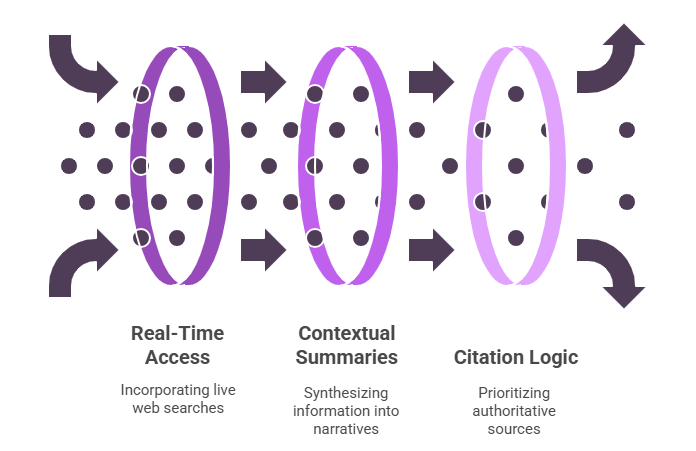Introduction to Generative AI SEO
Generative AI SEO combines the power of cutting-edge artificial intelligence with traditional search engine optimization techniques. By leveraging AI content models, you can produce relevant, engaging, and optimized content that satisfies both algorithms and human readers. In this guide, you will learn how to rank for important Generative AI keywords, structure your pages for maximum impact, and drive sustainable organic traffic.
Why Generative AI Matters for SEO
Generative AI is transforming SEO by enabling smarter, data-driven content strategies that align with evolving search engine algorithms and user preferences.
- Enhanced Keyword Discovery
AI models can surface niche and long-tail keywords based on real-time search trends and user queries, helping you target opportunities that competitors overlook. - Content Personalization
By analyzing user behavior and intent, Generative AI can tailor content recommendations, boosting relevance and engagement for different audience segments. - Semantic SEO Optimization
AI understands relationships between topics and entities, so you can build semantically rich content that search engines reward with higher visibility. - Accelerated Content Freshness
Automate updates and expand existing articles with the latest data and insights, ensuring your pages stay current and authoritative in fast-moving niches. - Generative Engine Optimization (GEO)
Go beyond traditional SEO by structuring content specifically for AI models and generative search platforms, focusing on clarity, context, and authority. - Actionable Insights and Testing
Generative AI tools can suggest on-page improvements and run rapid A/B tests on titles, headings, and meta descriptions, helping you iterate toward better performance continuously.
By weaving Generative AI into your SEO workflow, you unlock deeper audience insights, personalized user experiences, and scalable content production that keeps you ahead of the curve.
According to WSJ, over 40% of users report completing searches entirely within AI chat interfaces, reducing traditional click-throughs
How AI Search Engines Work
- Training Data vs. Real-Time Access
AI models are built on extensive, pre-trained datasets but often incorporate live web searches to provide up-to-date information and ensure responses reflect the latest developments. - Contextual Summaries
Instead of returning ranked lists of URLs, AI search engines synthesize information into concise, narrative answers that draw on expert blogs, forums, and structured pages to meet user needs directly. - Citation Logic
Unlike traditional link-based algorithms, AI prioritizes content from authoritative, credible sources and evaluates clarity and completeness of answers, ensuring users receive reliable information rather than simply the most linked pages.

Keyword Research for Generative AI Content
Seed Keywords
Begin with broad, high-volume terms that define your content’s core topic.
Examples:
- “Generative AI optimization”
- “AI-powered content strategy”
- “Generative AI search trends”
Long-Tail Keyword
These are more specific phrases that capture niche topics or common user queries.
Examples:
- “how to get featured in AI search summaries”
- “tools to structure content for AI discoverability”
- “optimize blog posts for ChatGPT visibility”
Competitor Analysis
Use platforms like Ahrefs, SEMrush, or Ubersuggest to research what keywords top-ranking sites are targeting for generative AI SEO.
Look for gaps such as:
- Missing FAQs
- Outdated tool recommendations
- Lack of schema implementation guides
This gives you an opportunity to create better-rounded content.
Search Intent Mapping
Segment your keywords based on what the searcher is likely trying to achieve:
- Informational Intent
• “What is AI search optimization”
• “How does generative AI impact SEO rankings” - Navigational Intent
• “Claude AI content guidelines”
• “Google Search Generative Experience (SGE) documentation” - Transactional Intent
• “Buy AI content optimization tool”
• “Best LLM-friendly SEO platforms for agencies”
On-Page Optimization Techniques
On-page optimization ensures each page clearly communicates its purpose to both users and search engines. By fine-tuning elements like titles, headers, and images, you improve crawlability, user experience, and ultimately your rankings.
Optimizing Images and Alt Text
• Compress images to improve page load speeds and reduce bounce rates.
• Provide descriptive alt text that reflects the image and includes keywords where relevant.
Example: alt="container garden with tomato and pepper plants on an apartment balcony"
Title Tags and Meta Descriptions
• Keep your title under 60 characters and front-load it with the main keyword.
Example (Urban Gardening):
“Urban Gardening Guide: Grow Veggies on Your Balcony”
• Write a meta description of 150–160 characters that naturally includes the primary keyword early.
Example (Urban Gardening):
“Learn easy balcony gardening tips to grow fresh vegetables in small spaces and boost your home harvest.”
Header Structure (H1, H2, H3)
• Use a single H1 that matches your page’s main topic.
Example: <h1>Urban Gardening Guide: Grow Veggies on Your Balcony</h1>
• Break content into logical sections with H2 headings, then use H3 for sub-points to aid readability and SEO.
Creating High-Quality Generative AI Content
User Intent Alignment
- Answer reader questions comprehensively.
- Use conversational tone and actionable steps.
Content-Length and Depth
- Aim for 1,200+ words for cornerstone pieces.
- Include examples, data points, and case studies.
Readability and Formatting
- Use short paragraphs, bullet lists, and call-out boxes.
- Embed table of contents for long articles to improve navigation.
Off-Page SEO and Link Building
- Guest Posts: Contribute to AI and marketing blogs with a backlink to your guide.
- Resource Roundups: Get featured in “Top AI Tools” lists.
- Social Shares: Promote excerpts on LinkedIn and Twitter using hashtags like #GenerativeAISEO and #AIContent.
Technical SEO for Generative AI Pages
Site Speed and Performance
- Implement lazy loading for images.
- Use a CDN and cache static assets.
Mobile-First Indexing
- Test pages with Google’s Mobile-Friendly tool.
- Ensure buttons and text are legible on small screens.
Structured Data and Schema Markup
Add Article schema to help search engines display rich snippets.

Ethics, Compliance, and Hallucination Mitigation
- Source Attribution: Always cite reputable sources; AI may hallucinate unsupported facts.
- Human Review Layer: Use AI for drafting but employ experts to verify accuracy and maintain brand voice.
- Privacy & Consent: If processing user data with AI, ensure compliance with GDPR or local regulations.
Advanced Tactics: Multimodal, Video & Voice
Multimodal Content: Diagrams, embedded quizzes, and interactive widgets are hard for AI to fully summarize, boosting on-page engagement.
Video SEO for AI: Include transcriptions and structured metadata; platforms like YouTube feed into AI search results A/B Testing Software.
Voice Search Optimization: Optimize for natural language questions and conversational phrasing.
Tools & Resources to optimize for Generative AI SEO
- Keyword & Topic Research: Ahrefs, SEMrush, AnswerThePublic.
- Prompt Testing: ChatGPT, Claude, Gemini.
- Schema Generators: Attrock Schema Generator, Google’s Structured Data Testing Tool.
- AI Visibility Analytics: Dark Visitors, Plausible Analytics.
Measuring Success: Metrics & Analytics
- AI Referral Traffic: Track domains like
chat.openai.com,perplexity.ai,claude.ai. - Conversion Attribution: Use “How did you hear about us?” fields.
- AI Search Visibility: Monitor brand presence in AI outputs weekly.
- Engagement & Behavior: Time on page, scroll depth, tool usage.
Implementation Roadmap & ROI
| Phase | Actions | Timeline |
|---|
| Audit & Setup | Crawlability check, schema implementation, robots.txt updates | 2 weeks |
| Content Build | Draft core articles, case studies, interactive assets | 4–6 weeks |
| Promotion | Secure brand mentions, guest posts, social media campaigns | Ongoing monthly |
| Measurement | AI referral tracking setup, monthly performance reviews | Monthly |
| Iteration | Prompt optimization, content refresh, technical enhancements | Quarterly reviews |
Investing in generative AI SEO can deliver a 3–5× uplift in discovery across both traditional and AI search channels within six months.
Key Takeaways
- Generative AI is changing search behavior, with tools like ChatGPT and Google’s SGE shaping how users find and consume content.
- To rank in AI-driven search, focus on clarity, structured content, and credibility — not just keywords.
- Use long-tail and intent-based keywords to target specific user queries that generative models often reference.
- Schema markup and structured formatting help AI models understand and cite your content more effectively.
- E-E-A-T signals (Experience, Expertise, Authority, Trust) are critical for gaining visibility in AI responses and summaries.
- Optimizing for AI requires ongoing testing, prompt engineering, and monitoring for AI visibility metrics.
Need help optimizing your website for AI visibility? Get a free 30-minute consultation with our AI SEO experts and learn how to structure your content for maximum discoverability across search engines and generative tools.
AI Search Optimization FAQs
How does Generative AI SEO differ from traditional SEO?
Traditional SEO targets ranking in link-based search results (e.g., Google’s blue links).
Generative AI SEO prioritizes being referenced directly in AI summaries and chat answers by optimizing for clarity, structure, and machine readability.
Will Google or other search engines penalize AI-generated content?
AI-generated drafts themselves aren’t penalized, but search engines require:
- E-E-A-T Signals: Demonstrate expertise, experience, authority, and trustworthiness.
- Originality: Add unique insights, data, or examples.
- Quality: Human editing for fact-checking, coherence, and brand voice.
How do I prevent AI hallucinations or inaccuracies?
- Source Attribution: Always cite reputable references.
- Human Review: Incorporate a review stage where experts validate facts and refine tone.
- Controlled Prompts: Use precise, constrained prompts and include source lists when possible.
How long does it take to see results from Generative AI SEO?
- Initial Movements: 4–8 weeks for AI interfaces to begin surfacing improved content.
- Significant Gains: 3–6 months of consistent optimization, fresh content updates, and backlink building.
Do backlinks still matter in AI-driven search?
Yes. While AI overviews cite content based on clarity and authority, credible backlinks remain a key E-E-A-T signal, boosting your content’s perceived trustworthiness.
How can I stay ahead as AI search evolves?
- Continuous Learning: Follow AI search updates from Google, OpenAI, and industry blogs.
- Iterative Testing: Regularly A/B test prompts, titles, and metadata.
- Invest in Unique Assets: Publish original research, interactive tools, and expert interviews that AI can’t replicate.







